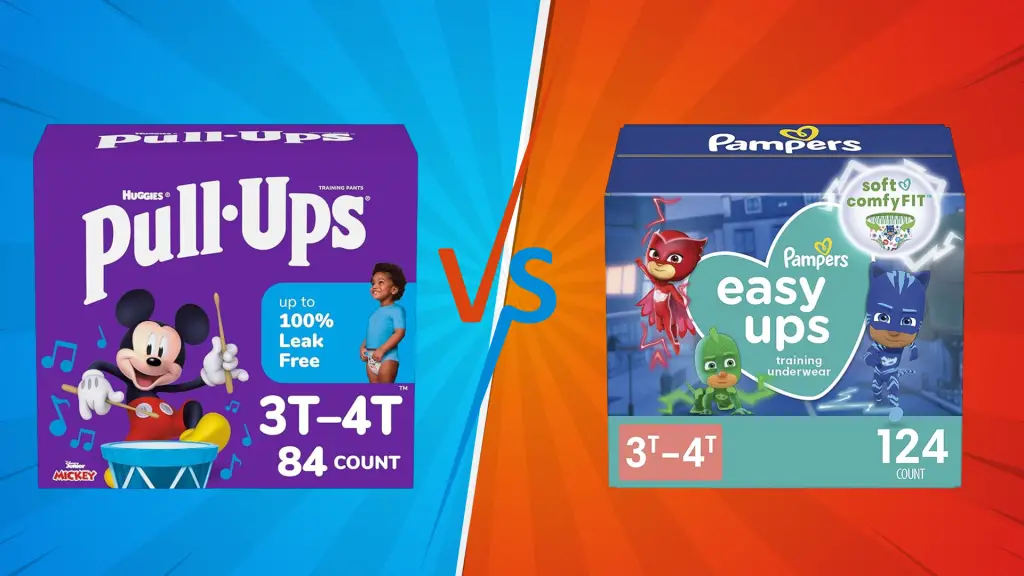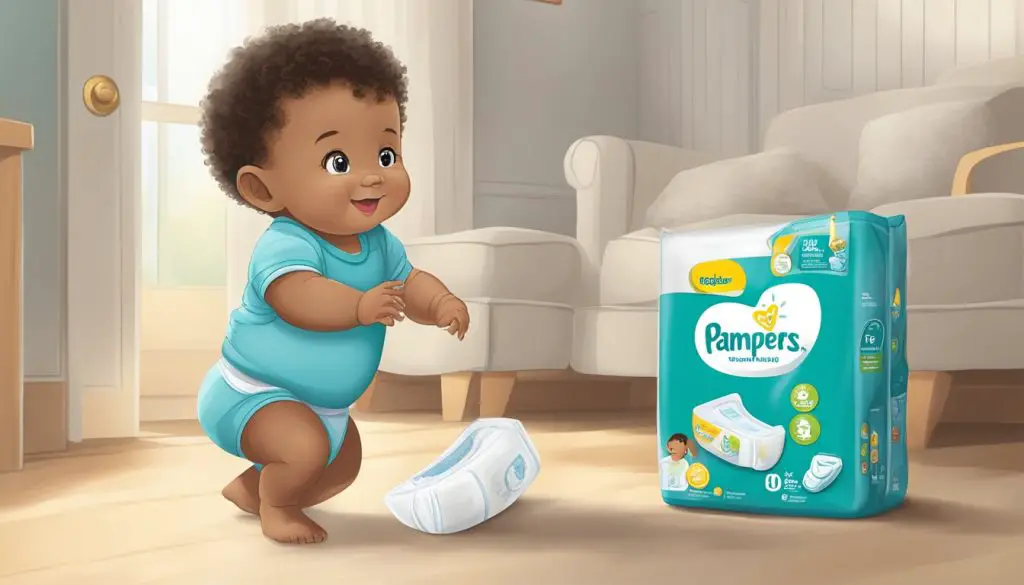When it comes to potty training, the debate of Huggies vs Pampers pull-ups is one every parent encounters. In this guide, we’ll dive into the key differences that set these popular brands apart, focusing on size, comfort, and price to help you make the best choice for your toddler.
Whether you’re leaning towards the snug fit of Huggies or the all-around comfort of Pampers, our insights will arm you with the knowledge you need for a smoother potty training journey.
Brand Overview

When it comes to diaper brands, two of the most popular and recognizable names are Huggies and Pampers. Both brands offer a wide range of products, including pull-ups designed for toddlers who are transitioning from diapers to underwear.
In this section, we’ll take a closer look at the history of Huggies and Pampers, as well as their product lines and availability.
History of Huggies and Pampers
Huggies and Pampers are both well-established diaper brands that have been around for decades.
Huggies was first introduced in 1977 by the Kimberly-Clark Corporation, while Pampers was introduced by Procter & Gamble in 1961. Since then, both brands have become household names and have expanded their product lines to include a variety of diapering products.
Product Line and Availability
Both Huggies and Pampers offer pull-ups designed for toddlers who are in the process of potty training – or like our youngest toddler – still need some help overnight.
Huggies pull-ups come in three sizes and are designed to fit children weighing between 18 and 50 pounds.
Pampers easy-ups, on the other hand, come in four sizes and are designed to fit children weighing between 16 and 41+ pounds.
You’ll have no issue finding either brand – both brands are widely available in major retailers such as Walmart and Target, and online retailers like Amazon.
Huggies are available at Costco but Pampers are not. Instead of Pampers, Costco carries their own Kirkland brand of diapers and pull-ups.
Design, Sizing Comfort, and Materials

When navigating the potty training journey, the choice between Huggies and Pampers pull-ups is crucial for both toddler comfort and parental convenience. Let’s dive into the nuances of design, sizing, comfort, and materials to help you make an informed decision.
Design and Aesthetics
Both brands boast engaging designs that appeal to little ones. Huggies Pull-Ups are celebrated for their fun, fade-when-wet designs that encourage toddlers to stay dry, turning potty training into a game. Pampers Easy Ups, with their 360-degree stretchy waistband, offer a design that’s not only visually appealing but also emphasizes comfort and flexibility.
Sizing and Shape for Every Toddler
Finding the right fit is essential, and both brands deliver with a range of sizes. Huggies cover the 18-50lbs range across three sizes, focusing on a snug, contoured fit to prevent leaks. Their Little Snugglers are perfect for newborns, featuring a pocketed waistband for extra security. Pampers, offering four sizes from 16lbs to 41+lbs, includes tear-away sides for easy removal, ensuring there’s a perfect fit for every stage of growth.
Unmatched Comfort
Comfort is where both brands shine, utilizing high-quality, hypoallergenic materials that are gentle on sensitive skin. Huggies pull-ups are lauded for their comfortable fit, with many parents noting a preference for Huggies in comparison to other brands. Pampers doesn’t lag behind, with Easy Ups designed to move with the child, thanks to their soft, stretchy waistband, ensuring comfort throughout the day.
Materials Tailored for Tender Skin
Both Huggies and Pampers prioritize your child’s delicate skin. Huggies diapers are hypoallergenic, offering a gentle touch, while Pampers features an umbilical cord cutout in their smallest sizes, protecting the healing belly button. This attention to detail in materials ensures that both brands offer safe, comfortable options for even the most sensitive of skins.
In the Huggies vs Pampers pull-ups debate, the choice boils down to personal preference, child comfort, and specific needs. Both brands offer unique advantages, from design and sizing to comfort and materials, making either a solid choice for your potty-training journey.
Absorbency and Leak Protection

Absorbency and leak protection stand at the forefront when picking pull-up diapers. Huggies and Pampers both boast dual leak-guard barriers designed to fend off leaks and accidents, ensuring your little one stays dry and comfortable.
Absorbent Materials
Huggies Pull-Ups harness the power of wood pulp combined with super absorbent polymers, capable of soaking up to 25 times their weight in liquid.
Pampers Easy Ups, in contrast, employ a mix of cotton and synthetic materials for their absorbency magic. This difference in material composition is the difference between each brand’s approach to keeping your child dry.
Leakage Protection Features Unpacked
Pampers Easy Ups take leak protection a step further with a 360-degree all-around stretchy waistband, ensuring a snug fit around your toddler’s waist to better prevent leaks.
Huggies Pull-Ups, while featuring a stretchy waistband at the sides complemented by a velcro tab, offer a more diaper-like experience. This design makes them straightforward to remove but might sacrifice some flexibility and comfort in comparison to the all-encompassing fit of Pampers.
Despite the differing designs, both brands are praised for their leakage protection features. However, Pull-Ups often receive higher marks for absorbency according to user reviews.
Additionally, both Huggies and Pampers provide nighttime options with enhanced absorbency to keep your little one dry throughout the night, ensuring a peaceful sleep for everyone.
Choosing the Right Fit: Huggies vs Pampers Through Every Stage

New Beginnings: Diapers for the Youngest
Both Huggies and Pampers understand the tender needs of newborns and infants, providing specially designed diapers to welcome the newest members of the family. For the littlest ones, Huggies Little Snugglers and Pampers Swaddlers offer a cozy embrace, complete with wetness indicators and a snug fit to protect sensitive skin and ensure comfort. These diapers are crafted for babies up to 10 pounds, promising a gentle touch right from the start.
As babies grow, their diaper needs evolve. Both brands scale up with Huggies Snug & Dry and Pampers Baby Dry, catering to infants and toddlers from 12 to 35 pounds. Engineered for longer wear times, including overnight, these diapers balance dryness and comfort, keeping up with your baby’s changing needs.
The Potty Training Journey
Embarking on the potty training adventure, Huggies and Pampers offer solutions to ease the transition. Huggies Pull-Ups and Pampers Easy Ups come in sizes that grow with your toddler, adorned with engaging designs to make potty training fun. While Huggies opts for a more diaper-like feel, Pampers leans towards an underwear-like fit with its 360-degree stretch, catering to different preferences and stages of readiness.
For the all-important overnight protection, Huggies Goodnites and Pampers UnderJams step up to the challenge. These training pants are specially formulated for night-time, providing the extra absorbency and leak protection needed to ensure a good night’s sleep, free from interruptions.
Ease of Use and Independence

The Transition to Independence
Potty training is a significant milestone, where ease of use and fostering independence play pivotal roles. Huggies and Pampers step up with training underwear designed to bridge the gap from diapers to real underwear effortlessly.
Understanding Fastening and Removal
The key distinction between Huggies Pull-Ups and Pampers Easy Ups lies in their design for fastening and removal. Huggies opts for Velcro closures on the sides, simplifying the process of removal and refastening for quick changes. Pampers, however, champions a 360-degree stretchy waistband, offering a design that mirrors real underwear, making it easier for toddlers to pull them up and down independently.
These design choices spotlight the brands’ commitment to supporting parents and toddlers through the potty training journey. Huggies Pull-Ups cater to those valuing quick and easy changes, while Pampers Easy Ups appeal to toddlers eager for a taste of independence.
Encouraging Toddler Autonomy
Both Huggies and Pampers have ingeniously incorporated features to promote self-reliance among toddlers. Huggies Pull-Ups, with their tear-away sides, empower toddlers to take charge by removing their training underwear solo, a crucial step towards self-sufficiency. This feature is not only practical but also boosts confidence, making the potty training experience positive and empowering.
Conversely, the 360-degree waistband of Pampers Easy Ups encourages toddlers to practice pulling up and down their training underwear, mirroring the actions they would take with real underwear. This design fosters an environment where toddlers can learn and practice independence, supported by products that are intuitive and child-friendly.
Cost and Value Comparison

Price Comparison
When it comes to price, both Huggies Pull-Ups and Pampers Easy Ups are similarly priced. However, there are some slight differences in their pricing.
| Retailer | Huggies Pull-Up Price Per Pull-Up | Pampers Pull-Up Price Per Pull-Up |
|---|---|---|
| Amazon | $0.41 per pull-up | $0.37 per pull-up |
| Walmart | $0.45 per pull-up | $0.39 per pull-up |
| Target | $0.42 per pull-up | $0.37 per pull-up |
Cost-Effectiveness
When it comes to cost-effectiveness, both Huggies Pull-Ups and Pampers Easy Ups are designed to be used during the potty training phase of toddlers.
They are both made with absorbent materials that can hold accidents and prevent leaks. So it comes down to the cost at your local stores, or if you’re able to stock up during sales.
This means that both brands are similarly priced in terms of diapers. However, Pampers Pull-Ups may be more cost-effective at most stores. Though the price is close enough that fit and leak prevention will far outweigh the cost savings of going with Pampers.
Wrapping Up: The Huggies vs Pampers Pull-Ups Debate
In the quest to find the perfect pull-up for your toddler, Huggies and Pampers stand out as frontrunners, each with their unique strengths and features. From the early stages of infancy to the triumphant moments of potty training, both brands offer solutions designed to support your child’s journey towards independence.
Whether you lean towards the customizable fit and quick-change convenience of Huggies Pull-Ups or prefer the underwear-like experience and independence-promoting design of Pampers Easy Ups, the choice ultimately hinges on your toddler’s needs and preferences.
As we’ve explored, the distinctions in design, absorbency, comfort, and ease of use play significant roles in deciding which brand best aligns with your parenting approach and your toddler’s stage of development. Both brands have their champions and critics, but the consensus remains: Huggies and Pampers provide quality options that cater to the varied needs of growing toddlers.
Remember, the journey of parenting—especially through milestones like potty training—is as unique as your child. Choosing between Huggies and Pampers isn’t just about the product; it’s about finding the right fit for your family’s lifestyle and your child’s comfort and confidence. Here’s to making those potty training days a little easier and a lot more rewarding for everyone involved.

